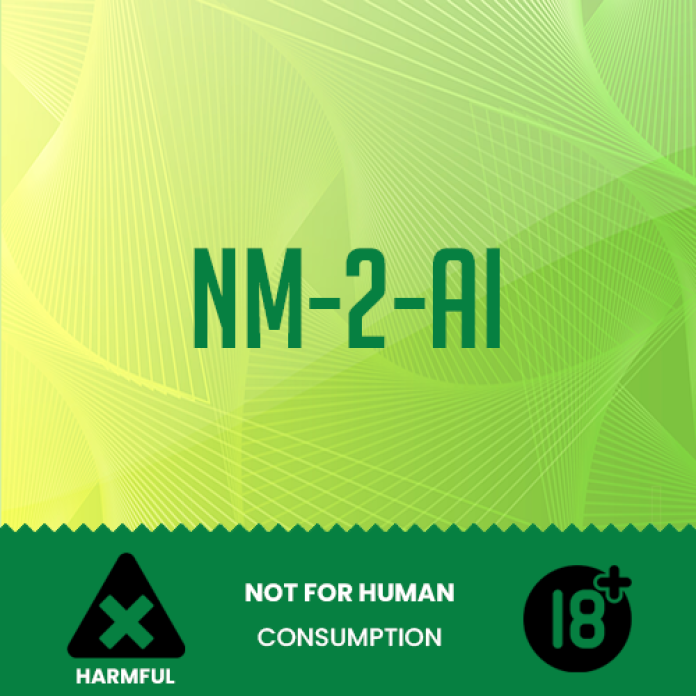N-Methyl-2-Aminoindane (NM-2-AI), also known as 2,3-dihydro-N-methyl-1H-inden-2-amine, is a New Psychoactive Substance (NPS) that has recently become more prominent in online markets. This compound belongs to the aminoindane class of substances and is recognized for its stimulant properties.
As a novel compound, NM-2-AI has drawn the interest of both recreational users and researchers due to its psychoactive effects and the ease of availability. Similar to its counterpart 2-Aminoindane (2-AI), NM-2-AI affects the central nervous system by changing the activity of certain chemicals (neurotransmitters), leading to various physiological and psychological effects. Compared to 2-AI, NM-2-AI has lower potency but a longer duration and similar effects. Recently, it has become easily accessible through online vendors selling research chemicals and designer drugs. There is very little information available about the effects, pharmacology, and toxicity of NM-2-AI. Therefore, it is highly recommended to use harm reduction practices if you decide to use this substance.
In recreational drug use, NM-2-AI is sold as a research chemical and often promoted as a legal alternative to more controlled drugs. This has made it popular in various online products, with users looking for its mind-altering effects. However, taking too much NM-2-AI can be dangerous and lead to serious side effects, discussed later in this article.
Chemical Composition
N-methyl-2-AI (NM2AI) is a modified version (N-methylated derivative) of 2-aminoindane (2AI), which itself is analogous to amphetamine. Both NM-2-AI and 2AI are derivatives of the controlled analog 5,6-methylenedioxy-2-aminoindane (MDAI). However, unlike MDAI, NM-2-AI and 2AI do not have a specific chemical group known as the methylenedioxy substituent.
NM-2-AI, with the IUPAC name N-methyl-2,3-dihydro-1H-inden-2-amine, belongs to the broader category of aminoindanes. These substances are structurally related to the well-known psychoactive compound MDMA. The molecular formula for NM-2-AI is C10H13N, and it is identified by the CAS number 10408-85-2. Its chemical structure includes an indane backbone, which is a combination of a benzene ring and a cyclopentane ring, with an amine group at 2-position and a methyl group attached to the nitrogen atom.
Key identifiers for NM-2-AI include:
- InChI Key: SXWZQUCTTOBHJT-UHFFFAOYSA-N
- SMILES Notation: CNC1CC2=C(C=CC=C2)C1
Action of NM-2-AI
Due to the lack of research on NM-2-AI, most information about its effects is based on its chemical structure and similarities to other stimulants like amphetamine, methamphetamine, and 2-FMA. Users report feeling more empathetic, sociable, mildly euphoric, and having increased sexual desire. It is believed that the mechanism of NM2-AI involves the release of monoamines, including dopamine (DA), norepinephrine (NE), and serotonin (5-HT). As a result, these neurotransmitters build up in the brain and produces stimulating, euphoric and mild hallucinogenic effects. However, the effects of NM-2-AI are generally considered less intense compared to MDMA.
Positive and Negative Health Effects: Based on User Reports and Personal Analyses
The effects listed below are based on anecdotal user reports and personal analyses. As a result, they should be viewed with a healthy degree of skepticism. These effects may not occur predictably, and higher doses are more likely to induce the full range of effects. Adverse effects, including addiction, severe injury, or death, become increasingly likely with higher doses.
1. Physical Effects
NM-2-AI is known for its energetic and stimulating effects, which are similar to those of amphetamine but stronger than modafinil or caffeine. This substance encourages physical activities like dancing, socializing, running, or cleaning. However, at higher doses, NM-2-AI can cause forced stimulation, making it difficult to stay still, with symptoms such as jaw clenching, involuntary shaking, and lack of motor control. Additionally, users often experience a noticeable increase in heart rate. As higher doses can lead to significant dehydration, it is crucial for users to stay hydrated. NM-2-AI can also reduce the desire to eat, leading to appetite suppression. Furthermore, some users report feelings of nausea and temporary erectile dysfunction during the drug’s active period. Increased perspiration is another common side effect, along with a rise in blood pressure, especially at higher doses. Finally, while teeth grinding is less intense compared to MDMA, it can still occur with NM-2-AI use.
2. After Effects
The “comedown” from NM-2-AI is often negative and uncomfortable due to neurotransmitter depletion. Common after-effects include increased feelings of anxiety, making users feel more mentally stressed. Cognitive fatigue is also prevalent, leaving users feeling mentally exhausted. Additionally, temporary depressive feelings can occur, adding to the overall discomfort. Irritability is another common symptom, with users reporting a heightened sense of frustration. A lack of motivation is often experienced, making it difficult to engage in tasks or activities. Thought processes can also slow down, leading to what is described as thought deceleration. Lastly, wakefulness is a frequent issue, with users finding it difficult to fall asleep or stay asleep.
3. Cognitive Effects
The cognitive effects of NM-2-AI vary with dosage and can include several notable impacts. At low to moderate doses, it can enhance focus, improving concentration; however, higher doses may impair focus. It is also more effective for tasks than 2-AI, offering motivation enhancement that can help users stay on track. While NM-2-AI provides euphoria, it is less intense compared to 2-AI, making it less suitable for recreational use. Additionally, it speeds up thought processes, known as thought acceleration, and increases alertness, reducing the need for sleep. Analysis enhancement is another benefit, improving analytical thinking. Memory performance is also boosted, contributing to memory enhancement. However, users may feel compelled to take more, leading to compulsive redosing. Finally, NM-2-AI enhances the enjoyment of music, increasing music appreciation.
Safety Profile
Although some users report positive experiences with NM-2-AI, the substance is associated with several side effects. These include:
- Increased heart activity: Users may experience a noticeable increase in heart rate, which can be concerning, especially at higher doses.
- Hyperthermia and excessive sweating: The body can overheat, leading to excessive sweating, which can be uncomfortable and potentially dangerous.
- Facial spasms: Involuntary muscle movements or twitching in the face can occur, which may be distressing or socially embarrassing.
- Erectile dysfunction: Temporary difficulty achieving or maintaining an erection can be a side effect during the drug’s active period.
- “Comedown” effects: Such as anxiety, irritability, cognitive fatigue, lack of motivation, slowed thinking, and insomnia
Given these potential risks, it is important for users to stay hydrated and carefully monitor their dosage.
User-Reported Dosages and Effects
Users of NM-2-AI report that its effects vary depending on the dosage, and they categorize the doses into “threshold,” “light,” “common,” and “strong.” For NM-2-AI, a threshold dose is considered to be greater than 50 mg, a light dose ranges from 50 to 100 mg, a common dose is between 100 to 150 mg, and a strong dose can be up to 150 to 200 mg. For 2AI, the dosages differ slightly: a threshold dose is 3 to 5 mg, a light dose is 5 to 10 mg, a common dose is 10 to 20 mg, and a strong dose is 20 to 40 mg.
Higher dosages of NM-2-AI, especially those in the “strong” category, are more likely to result in side effects. Users often mention that NM-2-AI is popular at parties as an alternative to MDAI. Because, it provides stimulant effects similar to classic amphetamines like MDMA.
The onset of these effects typically occurs within 30 to 60 minutes after ingestion, and the duration of the effects lasts between 1 to 4 hours. However, users should be cautious of potential side effects, which are discussed above.
To reduce these negative side effects, it is important to drink plenty of water and keep track of how much NM-2-AI you are taking. NM-2-AI is often used in social settings like parties because of its stimulating effects, but knowing the risks is key to using it safely. This information is especially useful for people in the luxury and wellness sectors, where enjoying the experience while staying safe is very important.
Metabolism of NM2-AI: Based on Research Study
In a research study, the metabolism of N-methyl-2-aminoindane (NM-2-AI) was assessed using both human liver and rat urine samples. The researchers used pooled human liver microsomes (pHLMs), pooled human liver S9 fraction (pS9), and rat urine samples after oral administration of the compounds. When NM2-AI was incubated with human liver enzymes, it underwent hydroxylation, resulting in the formation of hydroxylamine and various diastereomers, which are mirror-image compounds. Further testing with the human liver S9 fraction showed that NM-2-AI mainly produced a hydroxylamine. In rat urine, the metabolites of NM-2-AI were several hydroxylated forms, which appeared in urine as sulfates, except for the hydroxylamine. This suggests that similar metabolic patterns might occur in humans, making it essential to screen for both the parent compounds and their metabolites during urine drug testing. Overall, the research provides valuable insights into the metabolic pathways of NM-2-AI.
Behavioral Studies of NM-2-AI in Mice
In a study, researchers gave mice different doses of NM-2-AI (1–100 mg/kg) to see how it affected their senses and movement. They performed various tests, such as checking vision, measuring body temperature, testing pain response, assessing grip strength, and evaluating overall movement. Firstly, high doses of NM-2-AI made it much harder for the mice to see and move normally. They moved less and had weaker muscles. Additionally, NM-2-AI caused mild hallucinogenic effects, which were confirmed through tests that measure sensory information processing. These higher doses made it difficult for the mice to process sensory information, similar to the effects of known hallucinogens. Interestingly, NM-2-AI increased the mice’s pain tolerance during mechanical pain tests, suggesting it might have pain-relieving properties. However, it did not change their response to heat pain.
Pharmacokinetic Studies of NM-2-AI in Mice
In a pharmacokinetic study, researchers measured the levels of NM-2-AI and its metabolites in the blood of mice over time. NM-2-AI reached its highest concentration in the blood 30 minutes after injection. The main metabolite found was 2-aminoindane (2AI), which increased over time, showing that it stayed in the bloodstream for a while. As time passed, the ratio of 2AI to NM-2-AI increased, indicating that NM-2-AI breaks down into 2AI. This suggests that 2AI might play a significant role in the effects of NM-2-AI. Therefore, it is important to consider both NM-2-AI and its metabolite 2AI when evaluating the impact of NM2-AI.
Dangerous Interactions/Warnings
Many psychoactive substances that are reasonably safe to use on their own can become dangerous and even life-threatening when combined with certain other substances. Here are some known dangerous interactions, although this list may not include all possible risks.
Combining NM-2-AI with other stimulants can be especially risky. Stimulants like NM-2-AI can significantly increase heart rate and blood pressure, and when combined with other stimulants, these effects can reach dangerous levels. For example, mixing NM-2-AI with 25x-NBOMe or 25x-NBOH compounds, which are highly stimulating and physically straining, should be strictly avoided. Such combinations can lead to excessive stimulation, heart strain, increased blood pressure, vasoconstriction, panic attacks, thought loops, seizures, and in extreme cases, heart failure.
Alcohol is another substance that should not be mixed with NM-2-AI. Stimulants can mask the depressant effects of alcohol, leading to accidental over-intoxication. When the stimulant effects wear off, the unopposed depressant effects can cause blackouts and severe respiratory depression. It is important to limit alcohol intake if combining it with any stimulant.
Combining NM-2-AI with DXM (dextromethorphan) is also dangerous due to DXM’s effects on serotonin and norepinephrine reuptake. This increases the risk of panic attacks, hypertensive crisis, or serotonin syndrome, especially when combined with serotonin releasers like MDMA. Blood pressure should be monitored carefully, and strenuous physical activity should be avoided.
Mixing NM-2-AI with MDMA can enhance the neurotoxic effects of MDMA and increase the risk of excessive blood pressure and heart strain. Similarly, combining NM-2-AI with MXE (methoxetamine) can dangerously increase blood pressure and the risk of mania and psychosis. Combining NM-2-AI with other dissociatives also raises the risk of delusions, mania, and psychosis.
Tramadol, which lowers the seizure threshold, can further increase the risk of seizures when combined with stimulants like NM-2-AI. The combination of NM-2-AI with MAOIs (monoamine oxidase inhibitors) can increase the levels of neurotransmitters like dopamine to dangerous or fatal levels. Examples of MAOIs include Syrian rue, Banisteriopsis caapi, and some antidepressants. Lastly, combining NM-2-AI with cocaine can significantly strain the heart, increasing the risk of severe cardiovascular issues.
It is essential to conduct independent research and exercise caution when considering combining substances to avoid dangerous interactions.


